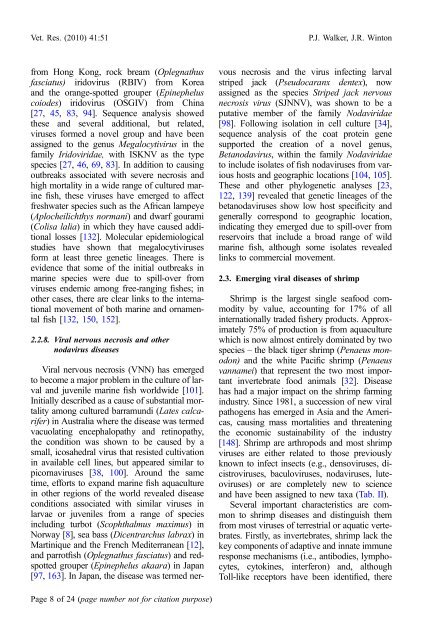Emerging viral diseases of fish and shrimp - Watershed Watch ...
Emerging viral diseases of fish and shrimp - Watershed Watch ...
Emerging viral diseases of fish and shrimp - Watershed Watch ...
You also want an ePaper? Increase the reach of your titles
YUMPU automatically turns print PDFs into web optimized ePapers that Google loves.
Vet. Res. (2010) 41:51<br />
P.J. Walker, J.R. Winton<br />
from Hong Kong, rock bream (Oplegnathus<br />
fasciatus) iridovirus (RBIV) from Korea<br />
<strong>and</strong> the orange-spotted grouper (Epinephelus<br />
coiodes) iridovirus (OSGIV) from China<br />
[27, 45, 83, 94]. Sequence analysis showed<br />
these <strong>and</strong> several additional, but related,<br />
viruses formed a novel group <strong>and</strong> have been<br />
assigned to the genus Megalocytivirus in the<br />
family Iridoviridae, with ISKNV as the type<br />
species [27, 46, 69, 83]. In addition to causing<br />
outbreaks associated with severe necrosis <strong>and</strong><br />
high mortality in a wide range <strong>of</strong> cultured marine<br />
<strong>fish</strong>, these viruses have emerged to affect<br />
freshwater species such as the African lampeye<br />
(Aplocheilichthys normani) <strong>and</strong> dwarf gourami<br />
(Colisa lalia) in which they have caused additional<br />
losses [132]. Molecular epidemiological<br />
studies have shown that megalocytiviruses<br />
form at least three genetic lineages. There is<br />
evidence that some <strong>of</strong> the initial outbreaks in<br />
marine species were due to spill-over from<br />
viruses endemic among free-ranging <strong>fish</strong>es; in<br />
other cases, there are clear links to the international<br />
movement <strong>of</strong> both marine <strong>and</strong> ornamental<br />
<strong>fish</strong> [132, 150, 152].<br />
2.2.8. Viral nervous necrosis <strong>and</strong> other<br />
nodavirus <strong>diseases</strong><br />
Viral nervous necrosis (VNN) has emerged<br />
to become a major problem in the culture <strong>of</strong> larval<br />
<strong>and</strong> juvenile marine <strong>fish</strong> worldwide [101].<br />
Initially described as a cause <strong>of</strong> substantial mortality<br />
among cultured barramundi (Lates calcarifer)<br />
in Australia where the disease was termed<br />
vacuolating encephalopathy <strong>and</strong> retinopathy,<br />
the condition was shown to be caused by a<br />
small, icosahedral virus that resisted cultivation<br />
in available cell lines, but appeared similar to<br />
picornaviruses [38, 100]. Around the same<br />
time, efforts to exp<strong>and</strong> marine <strong>fish</strong> aquaculture<br />
in other regions <strong>of</strong> the world revealed disease<br />
conditions associated with similar viruses in<br />
larvae or juveniles from a range <strong>of</strong> species<br />
including turbot (Scophthalmus maximus) in<br />
Norway [8], sea bass (Dicentrarchus labrax) in<br />
Martinique <strong>and</strong> the French Mediterranean [12],<br />
<strong>and</strong> parrot<strong>fish</strong> (Oplegnathus fasciatus) <strong>and</strong> redspotted<br />
grouper (Epinephelus akaara) in Japan<br />
[97, 163]. In Japan, the disease was termed nervous<br />
necrosis <strong>and</strong> the virus infecting larval<br />
striped jack (Pseudocaranx dentex), now<br />
assigned as the species Striped jack nervous<br />
necrosis virus (SJNNV), was shown to be a<br />
putative member <strong>of</strong> the family Nodaviridae<br />
[98]. Following isolation in cell culture [34],<br />
sequence analysis <strong>of</strong> the coat protein gene<br />
supported the creation <strong>of</strong> a novel genus,<br />
Betanodavirus, within the family Nodaviridae<br />
to include isolates <strong>of</strong> <strong>fish</strong> nodaviruses from various<br />
hosts <strong>and</strong> geographic locations [104, 105].<br />
These <strong>and</strong> other phylogenetic analyses [23,<br />
122, 139] revealed that genetic lineages <strong>of</strong> the<br />
betanodaviruses show low host specificity <strong>and</strong><br />
generally correspond to geographic location,<br />
indicating they emerged due to spill-over from<br />
reservoirs that include a broad range <strong>of</strong> wild<br />
marine <strong>fish</strong>, although some isolates revealed<br />
links to commercial movement.<br />
2.3. <strong>Emerging</strong> <strong>viral</strong> <strong>diseases</strong> <strong>of</strong> <strong>shrimp</strong><br />
Shrimp is the largest single seafood commodity<br />
by value, accounting for 17% <strong>of</strong> all<br />
internationally traded <strong>fish</strong>ery products. Approximately<br />
75% <strong>of</strong> production is from aquaculture<br />
which is now almost entirely dominated by two<br />
species – the black tiger <strong>shrimp</strong> (Penaeus monodon)<br />
<strong>and</strong> the white Pacific <strong>shrimp</strong> (Penaeus<br />
vannamei) that represent the two most important<br />
invertebrate food animals [32]. Disease<br />
has had a major impact on the <strong>shrimp</strong> farming<br />
industry. Since 1981, a succession <strong>of</strong> new <strong>viral</strong><br />
pathogens has emerged in Asia <strong>and</strong> the Americas,<br />
causing mass mortalities <strong>and</strong> threatening<br />
the economic sustainability <strong>of</strong> the industry<br />
[148]. Shrimp are arthropods <strong>and</strong> most <strong>shrimp</strong><br />
viruses are either related to those previously<br />
known to infect insects (e.g., densoviruses, dicistroviruses,<br />
baculoviruses, nodaviruses, luteoviruses)<br />
or are completely new to science<br />
<strong>and</strong> have been assigned to new taxa (Tab. II).<br />
Several important characteristics are common<br />
to <strong>shrimp</strong> <strong>diseases</strong> <strong>and</strong> distinguish them<br />
from most viruses <strong>of</strong> terrestrial or aquatic vertebrates.<br />
Firstly, as invertebrates, <strong>shrimp</strong> lack the<br />
key components <strong>of</strong> adaptive <strong>and</strong> innate immune<br />
response mechanisms (i.e., antibodies, lymphocytes,<br />
cytokines, interferon) <strong>and</strong>, although<br />
Toll-like receptors have been identified, there<br />
Page 8 <strong>of</strong> 24 (page number not for citation purpose)

















